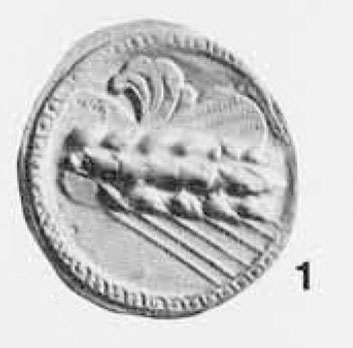
Coins contribute little to a discussion of Mediterranean trade in the 6th century, for there are no relevant hoards which can be securely dated earlier than 515 B.C. This is not as surprising as it would have seemed even five years ago. At that time we thought that the initial stage of coinage began around 640 and that the crucial Artemision deposit, our best evidence for the chronology, first published in 1908 by B. Head in D. G. Hogarth, Excavations at Ephesus, was laid down between 600 and 590. Now, in the opinion of some scholars, the latest of the ivories associated with the coins at Ephesus are products of the 570’s rather than the 590’s and if that is the case, the foundation deposit must be down-dated. Along similar lines, recent numismatic judgment, based on the contents of a large Egyptian hoard from Asyut, tends to accept at face value Herodotos’ statement (1.94) that the Lydians were the first to strike and use coins in gold and silver; see M. Price and N. Waggoner, Archaic Greek Silver Coinage (London 1975). The earliest silver would have been that of Croesus and the first silver issues of Greece proper would have been put out ca. 550 or slightly later. Pertinent, also, is Colin Kraay’s hypothesis, discussed in the Journal of Hellenic Studies, that the original function of coinage was related to the convenience and profit of the state, freeing it from the cumbersome process of weighing out miscellaneous lots of metal, and enabling it to control the quality of its receipts by demanding that official payments for harbor dues, taxes and so forth be made in units of its own creation and hence of attested weight and purity. The commercial advantages of such ready-made units would soon have been apparent but, according to Kraay, this was a secondary and later development.
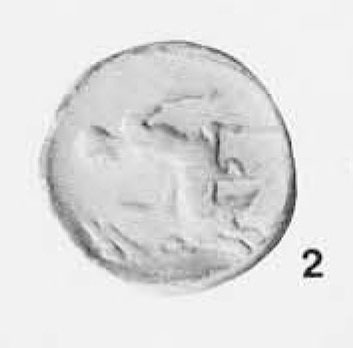
If there were relatively few mints in operation prior to 550 B.C. and if the earliest coins were primarily intended for local governmental transactions, it follows that the numismatic material has little or nothing to say about trade patterns during most of the 6th century. Only after 525 B.C. is there any evidence at all, and only in the 5th century is it adequate for interpretation.
Hoards and overstrikes provide the basic data, but the information should be used with discretion. In analyzing the hoards, one must remember that factors other than trade are involved in the movement of coins from one area to another. The “several hundred” darics found near the Elissus River in Athens may be a residue of the Persian Wars, just as the anomalous composition of the Taranto Hoard of 1874 is more easily explicable in terms of warfare than of trade. In it a great deal of South Italian and Sicilian material is combined with coins from Greek and Anatolian mints, many of them chisel-cut and fragmented. Since such coins are otherwise unattested in the West but are commonly found in the Levant and in Egypt, it seems possible that what we have here is the pay or loot of a returning mercenary added to, and buried with, his accumulation of local coinages.
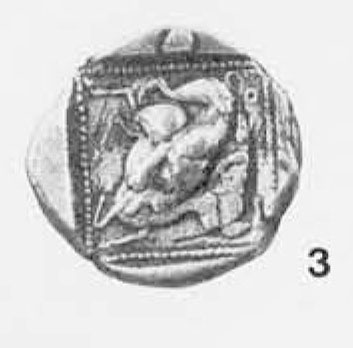
Even when a hoard as a whole is obviously to be associated with commercial activities, elements in it may be misleading in implying a direct link between place of origin and findspot. The Asyut Hoard from Middle Egypt is a good example of this. It contained a surprising number of coins of Sicily and South Italy, areas which rarely exported their currency and are scarcely ever represented in eastern hoards. Of the twenty-five Asyut specimens, fourteen were tetradrachms of the Samians, struck at Zancle during the five years that they occupied the city before their expulsion by Anaxilas of Rhegium ca. 489 B.C. Two others were earlier issues of Zancle; one came from Rhegium, and the remainder from Himera and three Italian mints. Where the Samian exiles went after they were forced to leave Zancle is not recorded but it has been suggested that they returned to Samos, presumably carrying with them as much treasure as they could amass. Some of the money they brought back, in the company of tetradrachms struck at Samos itself, would then have travelled along the standard trade route between Southwest Anatolia and Egypt to be buried finally at Asyut ca. 475 B.C. The fact that there is no Italian and Sicilian material in eight other Egyptian hoards of somewhat earlier date, interred between 500 and 485, is strong confirmation of special circumstances in the case of the Asyut Hoard.
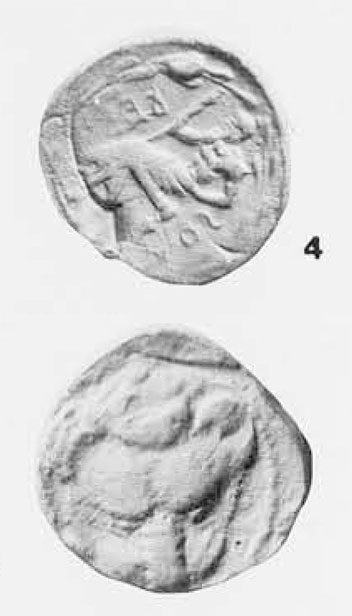
Other instances of special circumstances can be cited. Thirty staters of a single Lycian dynast, Tethiveibi, have no business turning up on the island of Lemnos. One assumes that they were the personal property of a traveller who brought them into a region, which they normally never penetrated in the course of trade. Certainly the 51 bronzes, chiefly Syracusan, found at Chalcis in Euboea must have been personally conveyed by some Sicilian who concealed his pitiful reserve of locally worthless money against the day when he could take it back with him to Syracuse.
These are all exceptional cases, but they do remind one of the need to use the hoard information with caution. Only the combined and congruous testimony of a number of deposits from the same general area is truly reliable evidence; any gross anomaly, whether it concerns a stray coin or a larger body of material, is suspicious.
With overstriking, the practice of restriking old coins, there is perhaps less danger of misinterpretation, although special circumstances again may muddy the waters. If Mint A used coins of Mint B as flans for issues of new money, the foreign coins were clearly a factor in the local economy. If the overstriking occurred with some regularity, it is probably safe to assume that trade was largely responsible for the imports. One cannot rule out other possibilities, but it is worth noting that the Cretan overstrikes of a later date which have been plausibly linked with the return of Cretan mercenaries and the incursions of Cretan pirates, involved massive influxes of a particular kind of coinage over a very limited period of time. It is also true that an isolated overstrike, like a single small hoard, may be considered a shaky piece of evidence but the record is, and inevitably always will be, fragmentary. No recent and systematic compilation of over-struck coins is available. C. H. V. Sutherland‘s survey in the Numismatic Chronicle was admittedly incomplete and little has been done to augment it in the intervening years except in the pages of individual mint studies. And what we have in any case is a record of failures. No mint is likely to have bothered to overstrike a few stray foreign coins. For every one with the undertypes inexpertly deleted, one may postulate others so successfully treated that all traces of conversion have disappeared.
Having dwelt at some length on the hazards and pitfalls of the numismatic evidence, let us see what its positive aspects are as we move from West to East.
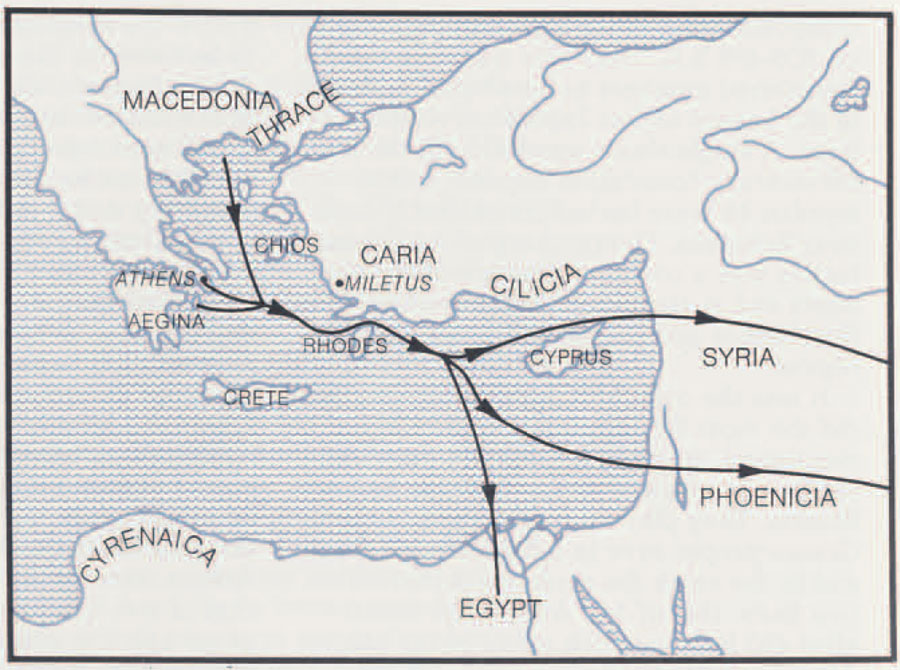
The 5th-century hoards of Magna Graecia are almost invariably “closed” deposits in the sense that they contain only issues of South Italian cities, Even the coinages of nearby Sicily are rarely present and when they do appear it is normally in a hoard buried at or near Rhegium, which for all practical purposes was a part of the Sicilian area and will be so regarded here. Overstrikes, however, serve to correct this one-sided picture. Numerous examples of Sicilian and Corinthian coins used as flans for issues of Magna Graecian cities point to strong links, presumably commercial, within that region. The foreign coins apparently did not pass into general circulation for they are not found in hoards, but they were certainly absorbed into the economy, at least on the state level, and probably in greater quantity than has sometimes been thought, if one allows for the fact that no record survives of coinage that went into the melting pot or was converted without leaving visible traces of overstriking. South Italian coinage, on the other hand, seems to have stayed at home. It is almost never overstruck except within the peninsula, and the hoard evidence is limited to two Metapontine staters in Spain and the handful of miscellaneous silver which presumably traveled to Asyut by way of Samos and the Samian exiles.
In Sicily the situation is somewhat less parochial. Foreign coins, chiefly Athenian owls, are found in hoards and sometimes in substantial numbers. Of nearly 1100 coins in the Gela Hoard of ca. 485-480, at least 187 specimens were Athenian, There is a scattering of Acanthus issues, present in three hoards, and of Corinthian staters but the latter do not appear until the very late 5th and early 4th centuries. Overstriking is comparatively rare: Gela over Mende, Selinus over Corinth, and a few examples of Rhegium and Messana over Athens, Unlike the coinages of South Italy, Sicilian strikings are found abroad but seldom in appreciable quantity: four pieces in the El Arahal Hoard near Sevilla which contained the two staters of Metapontum; an unspecified number in a find of 80 silver coins of Athens and Sicily interred at Bizerte, Tunisia, together with an ingot and jewelry; and a few strays in four sizable hoards from Cilicia, Syria and West Iran. It would be hard to argue that any of this, with the probable exception of the Tunisian material, is indicative of direct trade relationships.
Leaving aside the Sevilla and Bizerta hoards already mentioned, there is nothing relevant from Spain, Gaul or North Africa west of Cyrenaica. Two caches of mid 5th-century burial from the Marseille-Toulon area contained over 2000 silver fractions, mostly obols. Some are issues of Phocaea, the mother city of Massalia, and others come from Velia, another Phocaean colony, but the bulk of the material is now thought to be of local origin. In any event, such small denominations could have played no significant role in international commerce.
Moving to Greece proper and the major mints of the region—Corinth, Aegina and Athens—we encounter a different situation. All three states were commercial powers with access to ample supplies of bullion for the extensive coinages they produced. The flow of currency was invariably outward; local hoards contain local money and there was apparently no over-striking of foreign coins by any of the three mints.
As one would expect, Corinthian silver traveled west, to Magna Graecia where it was frequently overstruck, and to Sicily where it was hoarded in the late 5th and early 4th centuries. It appears in a number of Egyptian hoards of archaic date and in quantity sufficient to suggest ties between the two areas. Elsewhere it is notably absent.
Aegina’s staters on the other hand are not found in the west. At least until 431 B.C. they dominate the Peloponnese, where there was little competition from local mints, as well as the Cyclades and Crete. They are well represented in two hoards from Thessaly and one from Aetolia. Farther afield they accompany the coinages of Athens and northern Greece to Egypt, comprising over thirteen per cent of the composite total of ten Egyptian deposits of ca. 500-470 B.C. They also travel in sharply diminished numbers to Southwest Anatolia, to the Levant and as far east as Afghanistan, A single stater was found in the late 6th-century foundation deposit at Persepolis; 45 were buried considerably later near Ecbatana. Overstriking of Aeginetan turtles was a common practice of Cretan mints and is also recorded for the Cyclades, Elis, Samos and the Caria-Lycia-Cyprus region.
It was the owls of Athens, however, that did the most flitting about. As already mentioned, they are present in numerous Sicilian hoards and in the Tunisian find of Bizerta. They play no role in the hoards of Greece proper save in neighboring Euboea, and in the north the evidence is limited to two finds: that of Mt. Athos with burial after 400 B.C. in which many of the 100 Athenian tetradrachms must be of 5th-century date, and a recent discovery in the Black Sea region, interred ca. 425, in which sixteen of the 108 recorded coins are Athenian owls, In general, their path parallels that of the turtles: Southwest Anatolia, Egypt, the Levant and further East. Seventeen per cent of the coinage in the ten archaic Egyptian hoards cited earlier consisted of Athenian money, but it is worth noting that only in the latest two hoards of 475 and 470 were the owls present in impressive quantity. In two 5th-century Syrian hoards Athenian tetra-drachms comprised over one-third of the total number of coins, and in three deposits from West Iran, Bactria and Cabul, buried in the first quarter of the 4th century but largely composed of earlier material, they accounted for over one-half of the imported issues. Overstriking is very rare, attesting the prestige of Athens’ silver, but there are a few examples from Sicily, Cyrenaica and Cyprus. Further evidence of the extent to which Athenian coinage dom inated the southeastern Mediterranean is to be found in the many local imitations. As the flow of owls diminished or dried up in the late 5th and early 4th centuries, the types were reproduced in Egyptian, Syrian and Phoenician workshops—sometimes so faithfully that it is difficult to distinguish a copy from an original.
Another region copiously endowed with silver was northern Greece where the cities and tribes were able to export bullion as a commodity in the form of coins, often of over-size denomination, and undoubtedly ingots and bars as well. Except for a few overstrikes by South Italian mints and a scanty representation of Acanthus in Sicilian hoards, the pattern of foreign distribution is similar to that of Aegina and Athens. One of the earliest silver hoards, that of Ras Shamra with a burial date of ca. 515-500, contained 32 ThracoMacedonian issues along with six staters of nearby Cyprus; the small foundation deposit at Persepolis had a tetradrachm of Abdera. In later hoards from the Levant and the East, the proportionate representation is, on the whole, lower than that of Athens or Aegina, but in the archaic Egyptian hoards of 500-470 B.C. thirty per cent of the entire coinage was produced by Thraco-Macedonian mints. Practically nothing in the way of foreign money entered the region save for drachms of Parium and the electrum staters of Cyzicus, a universally acceptable trade currency which circulated widely in the Euxine and the Aegean. Hoards of Cyzicenes, occasionally in the company of Persian darics or Lampsacene electrum, have turned up in the Crimea, coastal and inland Bulgaria, the Cyclades, Elis, the Piraeus, Chios and Clazomenae.
Below is an inventory of hoard contents. Figures in parentheses indicate the total of identifiable coins from one or more hoards. All four eastern hoards were buried in the first quarter of the 4th century but most of the material had entered the area before 400 B.C.
Southwest Anatolia
| ca. 500-480 (48) | ca. 460-450 (87) | ca. 430 (28) | ca. 400-380 (c. 1375) | |
|---|---|---|---|---|
| Italy-Sicily | 1 | 2 | ||
| No. Greece | 8 | 29 | ||
| Athens | 20 | 30 | 2 | 240 |
| Aegina | 11 | 4 | 2 | |
| Cyclades | 2 | |||
| Corinth | 1 | |||
| SW Anat. | 3 | 7 | 5 | c.1100 |
| Other Anat. | 2 | 2 | 2 | 6 |
| Cyprus | 2 | 3 | 12 | 20 |
| Cyrenaica | 10 | 2 | ||
| Phoenicia | 3 | 7 |
Egypt
| ca. 500 (174) | ca. 495-485 (157) | ca. 475 (798) | ca. 470 (84) | |
|---|---|---|---|---|
| Italy-Sicily | 25 | 1 | ||
| No. Greece | 73 | 62 | 207 | 23 |
| Athens | 16 | 165 | 34 | |
| Aegina | 17 | 10 | 132 | 9 |
| Cyclades | 10 | 7 | 14 | 1 |
| Corinth | 10 | 9 | 39 | 1 |
| Other Greece | 3 | 27 | 1 | |
| SW Anat. | 44 | 26 | 92 | 9 |
| Other Anat. | 2 | 4 | 13 | 3 |
| Cyprus | 14 | 12 | 42 | 1 |
| Cyrenaica | 4 | 8 | 42 | 1 |
The Levant
| ca. 515-500 (38) | ca. 495-485 (157) | ca. 475 (798) | ca. 470 (84) | |
|---|---|---|---|---|
| Italy-Sicily | 1 | 2 | ||
| No. Greece | 32 | 10 | 13 | 4 |
| Athens | 12 | 31 | 35 | |
| Aegina | 2 | 11 | ||
| Cyclades | 1 | 3 | ||
| Corinth | 1 | |||
| Other Greece | 2 | 1 | ||
| SW Anat. | 13 | 2 | ||
| Other Anat. | 4 | 2 | 1 | |
| Cyprus | 6 | 21 | 4 | |
| Cyrenaica | ||||
| Phoenicia | 2 | 19 |
The East
| Mesopotamia (16) | W. Iran (392) | Balkh (170) | Cabul (64) | |
|---|---|---|---|---|
| Italy-Sicily | 6 | |||
| No. Greece | 14 | 5 | 3 | |
| Athens | 6 | 167 | 151 | 34 |
| Aegina | 1 | 45 | 1 | 4 |
| Cyclades | 6 | 1 | ||
| Corinth | ||||
| Other Greece | 7 | 1 | ||
| SW Anat. | 12 | 8 | 13 | |
| Other Anat. | 3 | 2 | ||
| Cyprus | 2 | 3 | 4 | 6 |
| Cyrenaica | 1 | |||
| Phoenicia | 3 | 128 | 1 |
Most Asia Minor hoards consist predominantly of local material. It is only in the southwest, the coastal area from Miletus to the Cilician border and the adjacent islands from Chios to Rhodes, that one finds deposits with any significant amount of foreign money. Athens is well represented throughout the 5th century and northern Greece down to ca. 450 B.C. There is some Aeginetan material and some from Cyrenaica; Phoenician issues begin to trickle in during the second half of the century. Movement outward is to the south and east: Syria, Iran, Bactria and Cabul, but even more to Egypt where the coinages of Southwest Anatolia provide fourteen per cent of the contents of the early 5th-century hoards.
For the rest, Cyrenaica’s connections are mainly with Egypt on the evidence of the hoards, although the overstriking of Athenian coins points to links in that direction as well. Phoenicia, despite its importance as a maritime power, had no coinage of its own until the middle of the 5th century, and even after that date coins apparently played no role in trade between the motherland and the Phoenician colonies of the western Mediterranean. Shekels of Sidon and Tyre are found occasionally in Southwest Anatolia and inland Syria; they comprise nearly one-third of a hoard from West Iran.
To summarize, we have practically no numismatic evidence for trade in the western Mediterranean between 525 and 400 B.C. Only around the shores of the Ionian Sea is there a clear pattern of movement: Sicilian coinage to Magna Graecia; Athenian owls to Sicily; Corinthian Pegasi to southern Italy, to Egypt in some quantity prior to 475 B.C., and to Sicily toward the end of the century.
In the eastern Mediterranean the situation is quite different. There the hoards point to an active trade route, with coins travelling in a triple stream from Thrace-Macedonia, Athens and Aegina to the coast and islands of Southwest Anatolia, to Egypt, to the Levant and farther east.
For the most part the coinage is flowing into areas that at the time had no extensive resources of local bullion and no indigenous currency. Hoards, particularly those found in Egypt, contain bars, ingots and chunks of silver along with struck money. That the coins were never intended to circulate as currency is evident from their condition. Many have been defaced by single slashes of the chisel, presumably to test the purity of the metal; others have been gouged, partially severed and fragmented. Within Egypt these mutilated coins were not units of trade but bullion to be divided as required to make up a certain weight of silver.
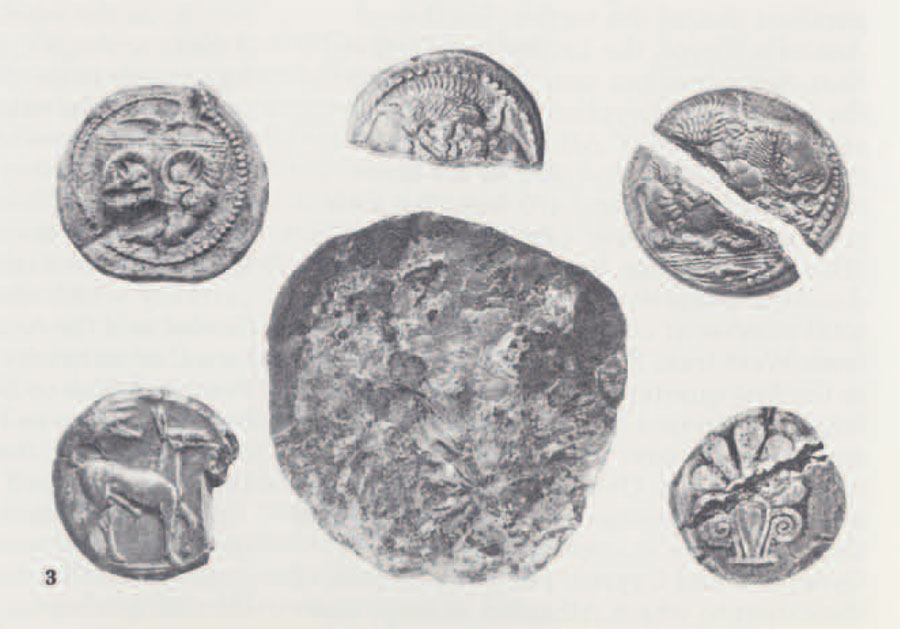
The strength and direction of the three streams of coinage seem to have varied from time to time. During the late 6th century and the early decades of the 5th, the coinages of the Thraco-Macedonian area were predominant in the hoards of the Levant and Egypt. After the Persian Wars many of the local tribes were incorporated into the Macedonian kingdom, with the result that their emissions stopped or were drastically curtailed. Fairly substantial civic coinages continued to be produced and distributed but by 450 the flow of northern silver had dwindled.
Aegina’s monetary impact was considerably weaker. In the early period, prior to 470, her turtles traveled in quantity to Southwest Anatolia and to Egypt but not to the Levant. They are rarely found in mid-century hoards from any area and their rather high representation in two hoards from north Phoenicia and West Iran, buried between 425 and 375, may indicate nothing more than the second-hand transfer of old money from one region to another. Given Aegina’s loss of naval supremacy in the Aegean after 479 and the expulsion of her inhabitants in 431, there is nothing surprising about the dearth of turtles in hoards interred after 470 B.C.
The earliest coins of Athens, the so-called Wappenmünzen, were apparently never struck in quantity and rarely traveled. Even the first owls seem to have stayed close to home. Looking at the data from Egypt, which provides the bulk of the evidence for the archaic period, one notes that there is not a single Athenian coin among the 174 found in four hoards buried ca. 500 B.C. With the beginning of the 5th century, however, Athenian owls are on the move—to Southwest Anatolia, the Levant and Egypt. They hold second place in the large Asyut Hoard of ca. 475; and in all recorded later hoards, with one exception, they comprise the largest segment of foreign money. By 425 the flow of coinage from Greece along the trade routes of the southeastern Mediterranean is virtually an Athenian monopoly. Nowhere is this more evident than in Egypt where the vast Tell el Maskhouta Hoard of the early 4th century yielded over 6000 Athenian tetradrachms along with some local imitations and nothing else, save for one stater of Tyre and an eastern imitation of Athens, possibly from the Gaza region. The disastrous defeats of the Peloponnesian War would eventually cripple Athens’ economy, but until then her owls had no rivals.
